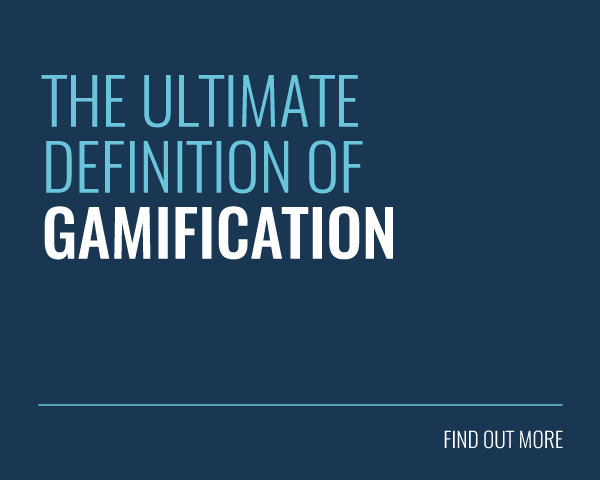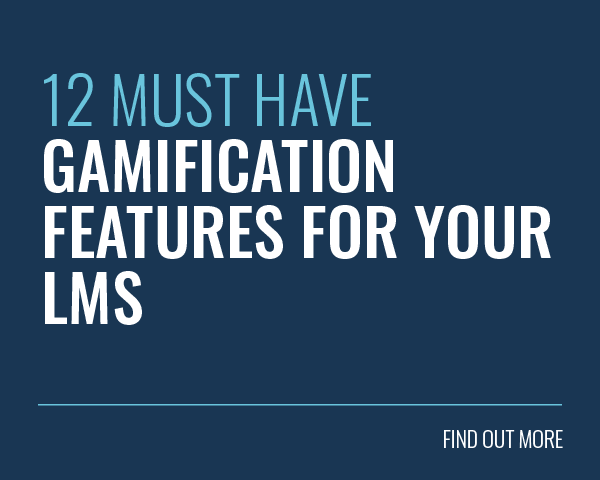The word ‘gamification’ can have playful connotations that may sound incongruent with the word ‘professional’. However, that couldn’t be further from the truth.
A learning professional will often use gamification to create more engaging learning experiences. It works well because it appeals to humans most basic needs, such as a sense of autonomy and competence. Consequently, the use of gamification in training has been shown to cause a 60% increase in employee engagement.
It’s not all just fun and games (pun intended). It’s a professional way for organisations to take their training to the next level. This article will walk you through the basics of gamification, the brain science behind it, the benefits and more. Most importantly, we will also showcase the different ways you can apply gamification across your learning systems in a professional way that meets the needs and requirements of your audience.
Without further ado, let’s get going!
What Actually is Gamification?

Gamification is ‘the application of game mechanics to non-gaming environments to make difficult tasks more palatable’. By making learning more exciting, gamification increases learner engagement and motivation. However, it isn’t a magic wand you can wave to solve all your training problems. It requires a strategic approach.
There are a variety of game mechanics you can apply to your online learning environment to drive engagement. These include:
- Experience Points (XP) – These act as a virtual currency that learners receive in exchange for completing actions on their learning platform. This includes activities like completing modules and adding posts to social feeds.
- Battles – Battles see learners face-off in fast-paced quizzes to prove their mastery over a subject. These are a fun and engaging way for learners to reinforce their knowledge.
- Leaderboards – Leaderboards track learner performance against other users on the platform. This works by tapping into your learners intrinsic motivation and fulfilling personal goals.
- Badges – Learners receive badges for completing content or interacting with the platform. These badges act as virtual rewards and appeal to our desire to complete a set of collectables.
- Streaks – This game mechanic relies on activities being completed over multiple days (or an extended time period). For instance, you could set up a streak that requires users to log in to their learning environment every day for a week. This helps to encourage habit formation.
- Levels – Levels enable you to provide a structured pathway through your learning content. Once a learner has completed all the content within a level, they ‘Level Up’ and gain access to a new set of learning activities. This sense of progression helps to drive further engagement.
- Scorecard – The user’s scorecard showcases their progress within the learning environment. It gives them a sense of status and allows them to set new personal goals and objectives.
How Do People Feel About Gamification?
Well that depends on who you ask. A 2017 study with 10,499 participants found that gamification has a positive impact. It showed that gamification can effectively motivate learners into action and promote long-lasting engagement. However, other studies show the importance of context and a targeted approach when rolling out a gamified solution.
For gamification to work, you need to adopt a strategic approach. You can’t throw badges, points and leaderboards at your engagement problem and expect instant results! You need to ask and answer certain questions before you select your approach. We like to call these the 5 Ws:
- Who is the intended learner audience? Different groups of people will have different attitudes, motivations and time restrictions.
- Why are you creating the training programme? In other words, what’s your learning objective and how will your learners benefit from it?
- What behaviours are you trying to drive? These are things like collaborative learning and increased communication.
- When do you want them to engage with your learning platform? Whilst at work or at home?
- Which mechanics are most likely to appeal to your specific audience? Certain game elements will be more likely to incite engagement and have a lasting impact.
You need to select appropriate mechanics for your audience. Otherwise, your gamified training programme won’t succeed. This lack of alignment has led to gamification getting a bad rep, especially in professional environments.
For example, Battles work as they tap into a learner’s competitive nature. But if you’re working with a group of learners who don’t have a competitive nature, then this part of the programme will be ineffective. To help hone in on the best game mechanics for your organisation, it can be helpful to start with a test group. With pilots, you can implement a wide range of game mechanics. You can then gradually refine them based on what works successfully for your learners.
What Happens When You Use Gamification Correctly?
When implemented in a focused, targeted manner, gamification works wonders! Here are some stats to prove it:

- eLearning Industry found that 87% of employees agree that gamification makes them more productive.
- A study conducted by Engage Research and GMI saw 90% of participants say they enjoyed a gamified survey experience.
- A recent study saw 115 people split into two groups. One group received gamified training, whilst the other received standard (non-gamified) learning experiences. The gamification group went on to achieve the highest mean test scores. Moreover, they enjoyed the training experience more, were more engaged and retained their knowledge better.
Still not convinced? Here are some business examples with real world impact:
- A bank in Texas saw their conversion rate increase by 700%, once they started using gamification to inform their customers about their benefits.
- Starbucks gamified their loyalty programme by creating a rewards app. The more points earned, the better the rewards! This led to an increase in revenue of $2.65bn and membership growing by 25%.
- One of our Fortune 500 clients saw a major increase in learner engagement thanks to a use of professional gamification. Their users completed an average of 12 battles every month. As a result, territories using our gamified mobile app solution, The Knowledge Arcade, saw a 20% increase in sales.
So as you can see, gamification has the potential to cause real behaviour change and lasting business success. Especially when gamification is used in a professional context. See some more real-life Gamification examples!
Why Does Gamification Still Have Detractors?
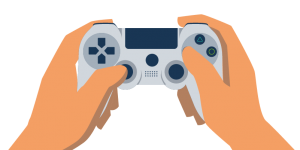
Despite the clear benefits of a professional gamification strategy, it still has a mixed reputation. But why? Unfortunately, many of the same prejudices that are lobbied against video games or gamers, are often pinned on gamification as well. Some see it as an unsophisticated solution. Others believe it suits a younger audience better. However, it’s no longer just young people who enjoy games.
A lot of the people who make up today’s workforce grew up playing video games. Perhaps they went to the arcade to play Pacman. Or more recently, perhaps they’ve been dabbling with Fortnite or Call of Duty: Warzone and other popular online games. Either way, games are a major part of the cultural fabric of the modern world. What’s more, This helps to explain why the average age of gamers has now reached 35-years-old. Furthermore, eLearning Industry found that 97% of employees above the age of 45 agree that gamification would help improve work.
Gamers make up over 2.7 billion of the world’s population. And of course, a lot of these people have jobs. How else would they afford to pay for all their games? So it makes sense that a gamified training programme would be enjoyed by a large number of employees around the world!
Not to mention, today’s workforce is well acquainted with social media. Learning systems like LMSs replicate social elements such as social streams, live chat and Expert Areas, where learners can interact with each other. This appeals to the human need to interact with others and seek peer-based approval. When gamification combines with social elements, it makes for a pretty powerful and professional training strategy!
Gamification and Theory
We all know that gamification is a very popular topic. As a result, there are numerous theories and frameworks that attempt to explain its motivational magic.
The Octalysis Framework
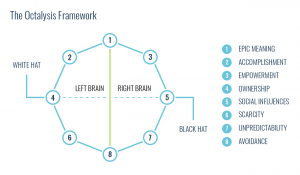
This popular framework was developed by Yu-kai Chou. It explores how games can motivate us into action by focusing on the eight core drivers of motivation. These include a sense of ownership, our motivation to avoid loss and wanting to express ourselves creatively.
The framework then categorizes the drives into Left and Right Brain Drives. Left Brain Drives are to do with logic, calculations and ownership. These tap into our extrinsic motivations and solely motivated by a goal or reward. Right Brain Drives connect to imagination, personal expression and social connection. They link to our intrinsic motivations. In other words, we are driven to act because the activity itself is rewarding.
The drivers are also either a White Hat or Black Hat Drive. White Hat Drives are ‘feel-good’ motivators and trigger positive emotions such as excitement or a sense of meaning. Whereas, Black Hat Drives trigger negative emotions such as rage, frustration and disappointment. They’re negative but very effective in creating a sense of urgency!
Head here if you want to read more about The Octalysis Framework!
Self Determination Theory
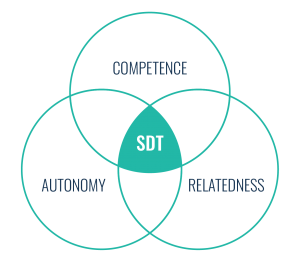
Another important theory that helps us to understand why gamification is so effective is Self-Determination Theory (SDT). Richard Ryan and Edward Deci devised it circa 1985. SDT is a popular theory that focuses on the ‘why’ behind human motivation. It has been cited over 44,000 times and is often used to devise a supercharged training programme.
The core idea behind SDT suggests that there are three psychological needs that are key to intrinsic motivation. If all these elements are in place, then we are likely to be motivated into action. The first element is competence. This means you’re confident in your abilities and are sure that you can perform a task. Accumulating XP, earning Badges and climbing Leaderboards helps to forge a sense of confidence. In turn, learners then become determined to continue nurturing their competence through their training.
The second element is autonomy. Humans want to feel like their hands are behind the wheel of their own life. You should consider this when designing your learning programmes. For example, offer your learners optional content that they can complete at their own pace. This helps to drive further ownership over their learning programme. You may even want to consider using branching level pathways to facilitate increased autonomy.
The last element is relatedness. As humans, none of us want to feel alone. We crave the feeling of belonging. Game mechanics like Battles and Leaderboards create connections with our colleagues and encourage social learning. Simultaneously, it breeds a knowledge sharing culture at work, which helps to save companies at least $31.5 billion a year.
All three of these elements lead to increased motivation and engagement which fosters enhanced performance and real business impact.
The Neuroscience Behind Gamification

You may be wondering how gamification actually works. How do game mechanics affect our brains in such a way that we are driven into action?
Well, it’s mainly down to neurotransmitters. Neurotransmitters are chemicals that your brain uses to send signals. The four that are important here are dopamine, serotonin, oxytocin and endorphins.
As you progress through a gamified training programme and earn XP, Badges and more, dopamine gets released in the nucleus accumbens. This creates a sense of pleasure and reward that drives positive associations with the training programme. Indeed, studies have shown that a lack of dopamine can have a detrimental effect on motivation and memory.
Serotonin, commonly referred to as the ‘happiness hormone’ is also at work here. It’s role is to stabilise our mood and maintain our wellbeing. Things like earning a new Badge or seeing the results on your Scorecard, will create feelings of pride in a learner. This then triggers a rush of serotonin and keeps people happy while learning.
Oxytocin is known to create feelings of trust and foster relationships with people. It’s often called the ‘love’ hormone. It can be nurtured through the use of social elements in a gamified training programme. Chatting to our peers on social feeds or sharing common interests in specific Clubs helps to make sure learners feel a closer bond.
The last neurotransmitter is endorphins. They boost feelings of pleasure and we trigger them when complete a task or achieve a goal. When we play games, it generates an endorphin rush which reduces feelings of stress. Gamified elements in training work exactly the same way. This often leads to increased memory retention and job performance.
The release of these neurotransmitters while learning creates a positive impact for learners. They help to increase engagement levels, memory retention and motivation!
Seven Tips to Create a Professional Gamification Strategy on Your Learning Technology Solution
So, we all know now what gamification is, how it works and what the benefits are. We’ve also dismissed some common misconceptions about gamification. The next question is this: how can you apply gamification to your learning environment in a professional manner to drive real results?
1. Focus Your Game Mechanics Around a Wider Goal

All training programmes should start with a clear goal in place. This could be an increase in product knowledge or better onboarding of new employees. Setting clear and measurable goals from the get-go will help you to select appropriate game mechanics.
For instance, if you are launching a sales training programme, you may lean heavily on leaderboards. After all, salespeople tend to be a naturally competitive bunch.
You should also ensure your training programme is brimming with epic meaning. You need to create a training programme that links to your mission, values and overall vision. Ensure your learners understand where they fit and what the benefits will be for them, if they complete the associated content. This will help to motivate your learners into action and improve engagement rates.
A great example of this is one of our clients Hard Rock. Their level structure started at ‘Level 1: Shower Singer’ and went all the way up to ‘Level 10: Rock Legend!’ This ensured that learners personal development was linked to the company and reminded them they’re part of a wider team.
2. Design the Gamification to Fit Your Brand
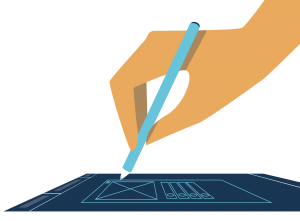
Many gamification solutions are customisable, so you can create an environment that maps neatly onto your brand specifications. Remember: you don’t have to utilise cartoonish imagery just because you’re using game mechanics. You can personalise your programme to include company colours, logos, names and more. This helps to make learners feel more comfortable and at home within their learning environment.
For example, we worked closely with Steinhoff Retail to ensure that their LMS accurately reflect their brand, mission and values. As such, they named their LMS ‘Steinhoff Learning Store’ and decided to work back to their South African roots. Each level that learners progressed through was also the name of a different African safari animal!
Although the platform was being used by three of Steinhoff’s businesses, it worked to bring all 20,000 of them under the same company umbrella and united them in working towards the same goals.
3. Track Learner Progress with Reports

Evaluating your learners’ progress is an important part of the process. Badges and XP are all well and good, but how do you know if your training is making a real impact? You need to make sure that your programme is effective and that it is generating return on investment (ROI). A learning management system, like The Academy LMS, allows you to see how learners are performing and provide real time feedback. A recent report found that 89% of managers agree that ongoing feedback and check-ins have a positive impact on their organization.
The Academy LMS offers extensive tracking and reporting features. This means you can also easily track learner progression alongside their business performance.
You should also use Levels and Progress Bars to help indicate where your learners are in their training journey. This helps to motivate learners into action and gives you an understanding of how their development is advancing.
4. Ensure Your Game Mechanics are Suited to Your Workers
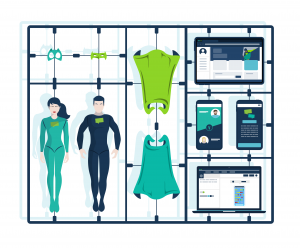
Different audiences will have different wants and needs. Whether you’re rolling out training for employees, partners, customers, members or other groups, it’s important to select the game mechanics that will work best for your learning ecosystem. If you don’t design your gamified training programme to suit your audience, you could actively end up disengaging them. This has a serious real world impact. A 2017 study of 1,500 respondents showed that disengaged employees cost companies between $450 and $550 billion a year.
For a corporate environment, game mechanics like XP and Levels provide a sense of progression and moving up the ladder. You should also encourage your learners to explore optional content within the learning library at their own pace. This fuels a sense of autonomy and gives them an opportunity to earn bonus XP and Badges.
5. Keep Weighting Consistent

It’s vital that learners feel that their rewards match their efforts. To help achieve this, you could categorise different actions into different bands based on their difficulty. For example, a ‘Bronze’ band could include actions that take less than two minutes to complete and may be worth 10XP. However, a ‘Gold’ band could include actions that are considerably harder and could earn a learner 100XP.
When XP earned from actions completed is consistent with the energy input, it increases motivation levels and encourages the release of neurotransmitters. Weighting should also be consistent across the platform to keep learners engaged. It also helps to imagine XP earned as a currency with its own value, which gives your learners a subconscious cue about how important each action is.
6. Provide Real World Context For Your Gamified Training

There’s not much point including content that doesn’t apply to learners’ actual jobs. Learning without real world context often leads to disengagement and a lack of business impact. Gamification allows real situations to be replicated and put professional’s skills to the test before performing something on the job.
For example, you can design curricula which include videos to watch, different classrooms on the topic to sign up for and assessments to take. You can configure these curricula to include Awards on passing. The Awards earned are then displayed in the Learner’s Badge Cabinet. Therefore, learners can easily check back and see all bases have been covered before heading into the real world. Awards can also be linked to a PDF certificate!
As a result of relevant training, companies can see a 37% increase in productivity and a 21% increase in revenue.
7. Link Rewards to the Business
 Many game mechanics provide learners with intrinsic motivation to complete actions on their learning platform. But you could also incorporate extrinsic rewards within your gamified training programme.
Many game mechanics provide learners with intrinsic motivation to complete actions on their learning platform. But you could also incorporate extrinsic rewards within your gamified training programme.
For instance, earning a pre-set number of Badges could entitle you to company branded items, a charitable donation or some other tangible reward.
On The Academy LMS, we use the Reward Centre to facilitate the exchange of virtual Badges and XP for real world rewards. This provides learners with an extra layer of motivation and helps to increase engagement. Better still, a survey by LinkedIn found that 94% of employees would be more willing to stay at a company that invested in their training.
You should also celebrate these achievements outside of the training programme. It’s important to highlight top performers in things like team meetings or internal newsletters. It helps to improve productivity and job satisfaction. In a survey involving 200,000 people, appreciation was selected as the most influential factor for happiness at work.
You can even take it further than that! For example, one of our clients hosts an annual awards ceremony where they hand out real awards to the best performers!
The Final Word
Gamification is taking the online learning world by storm. Its market size is predicted to keep growing and reach a global value of $30.7 billion by 2025. It’s no wonder that companies are looking for professional gamification strategies to implement it in their LMSs!
Gamification will work on your professional learning platform if you take the time to think things through properly. You should start by considering your audience. What are their wants and needs? How can you likely to motivate them into action? Is there anything that is likely to put them off?
Once you’ve achieved this, you should strive to create a gamified training programme that is clearly laid out, consistent and easy to track. If you are able to achieve all this, success should surely follow.
The Academy LMS is the world’s most engaging learning management system. It uses game mechanics to motivate your learners into action and help you achieve your training objectives. Want to learn more about how a professional gamification strategy can help you to engage your learners? Then please get in touch with us today!



